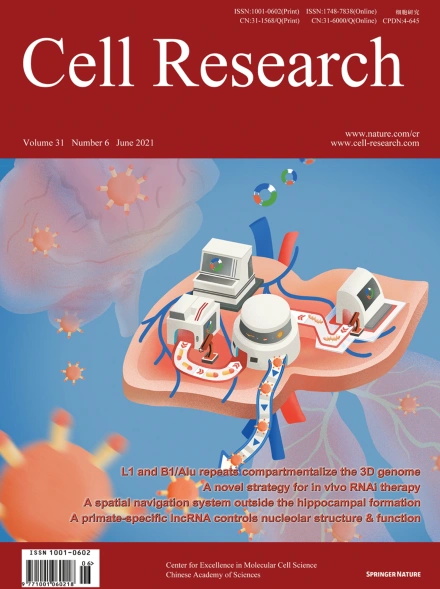
Advanced Search
Submit Manuscript
Advanced Search
Submit Manuscript
Volume 31, No 6, Jun 2021
ISSN: 1001-0602
EISSN: 1748-7838 2018
impact factor 17.848*
(Clarivate Analytics, 2019)
Volume 31 Issue 6, June 2021: 613-630 |
Homotypic clustering of L1 and B1/Alu repeats compartmentalizes the 3D genome
J. Yuyang Lu1 , Lei Chang2,3 , Tong Li1 , Ting Wang1 , Yafei Yin1 , Ge Zhan1 , Xue Han1 , Ke Zhang1 , Yibing Tao1 , Michelle Percharde4,5 , Liang Wang1 , Qi Peng1 , Pixi Yan1 , Hui Zhang1 , Xianju Bi1 , Wen Shao1 , Yantao Hong1 , Zhongyang Wu1 , Runze Ma6 , Peizhe Wang1 , Wenzhi Li1 , Jing Zhang1 , Zai Chang1 , Yingping Hou2 , Bing Zhu6 , Miguel Ramalho-Santos7 , Pilong Li1 , Wei Xie1 , Jie Na1 , Yujie Sun2,* , Xiaohua Shen1,*
1Tsinghua-Peking Joint Center for Life Sciences, School of Medicine and School of Life Sciences, Tsinghua University, Beijing 100084, ChinaOrganization of the genome into euchromatin and heterochromatin appears to be evolutionarily conserved and relatively stable during lineage differentiation. In an effort to unravel the basic principle underlying genome folding, here we focus on the genome itself and report a fundamental role for L1 (LINE1 or LINE-1) and B1/Alu retrotransposons, the most abundant subclasses of repetitive sequences, in chromatin compartmentalization. We find that homotypic clustering of L1 and B1/Alu demarcates the genome into grossly exclusive domains, and characterizes and predicts Hi-C compartments. Spatial segregation of L1-rich sequences in the nuclear and nucleolar peripheries and B1/Alu-rich sequences in the nuclear interior is conserved in mouse and human cells and occurs dynamically during the cell cycle. In addition, de novo establishment of L1 and B1 nuclear segregation is coincident with the formation of higher-order chromatin structures during early embryogenesis and appears to be critically regulated by L1 and B1 transcripts. Importantly, depletion of L1 transcripts in embryonic stem cells drastically weakens homotypic repeat contacts and compartmental strength, and disrupts the nuclear segregation of L1- or B1-rich chromosomal sequences at genome-wide and individual sites. Mechanistically, nuclear co-localization and liquid droplet formation of L1 repeat DNA and RNA with heterochromatin protein HP1α suggest a phase-separation mechanism by which L1 promotes heterochromatin compartmentalization. Taken together, we propose a genetically encoded model in which L1 and B1/Alu repeats blueprint chromatin macrostructure. Our model explains the robustness of genome folding into a common conserved core, on which dynamic gene regulation is overlaid across cells.
https://doi.org/10.1038/s41422-020-00466-6